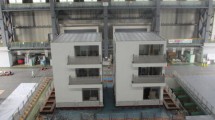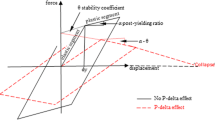Abstract
Reinforced concrete (RC) structures are common in seismic zones. However, damage assessment after earthquake events can be problematic and subjective due to their highly nonlinear and time-varying behaviour when damaged. This research develops a hysteresis loop analysis (HLA)-based method for rapid structural health monitoring of an experimental, scaled 12-storey RC frame building subjected to two levels of input ground motions. A six equivalent degree-of-freedom (DOF) system model is proposed to represent the 12-storey test structure, where the accelerations of every two floors are recorded during earthquake excitations. Hysteresis loops are then reconstructed for each DOF using the calculated equivalent restoring force and divided into a number of half cycles in chronological order. Finally, changes in elastic storey stiffness used as a damage index are tracked over time for damage identification of each DOF based on the statistical analysis of the selected half cycles. The identification results clearly show that the proposed algorithm is capable of identifying damage that was not evident by external visual appearance, and also offers significant advantages in identifying the location and severity of damage over traditional methods for realistic RC structures immediately after an event.















Similar content being viewed by others
References
Mahin SA (1998) Lessons from damage to steel buildings during the Northridge earthquake. Eng Struct 20(4):261–270
Malley JO (1998) SAC Steel Project: summary of Phase 1 testing investigation results. Eng Struct 20(4):300–309
Tremblay R, Filiatrault A, Bruneau M, Nakashima M, Prion HG, DeVall R (1996) Seismic design of steel buildings: lessons from the 1995 Hyogo-ken Nanbu earthquake. Can J Civ Eng 23(3):727–756
Krawinkler H, Zohrei M (1983) Cumulative damage in steel structures subjected to earthquake ground motions. Comput Struct 16(1):531–541
Nader M, Astaneh A (1991) Dynamic behavior of flexible, semirigid and rigid steel frames. J Constr Steel Res 18(3):179–192
Sabelli R, Mahin S, Chang C (2003) Seismic demands on steel braced frame buildings with buckling-restrained braces. Eng Struct 25(5):655–666
Stelmack TW, Marley MJ, Gerstle KH (1986) Analysis and tests of flexibly connected steel frames. J Struct Eng 112(7):1573–1588
Yamanouchi H, Midorikawa M, Nishiyama I, Watabe M (1989) Seismic behavior of full-scale concentrically braced steel building structure. J Struct Eng 115(8):1917–1929
Yoshimoto R, Mita A, Okada K (2005) Damage detection of base-isolated buildings using multi-input multi-output subspace identification. Earthq Eng Struct Dyn 34(3):307–324
Maeck J, Wahab MA, Peeters B, De Roeck G, De Visscher J, De Wilde W, Ndambi J-M, Vantomme J (2000) Damage identification in reinforced concrete structures by dynamic stiffness determination. Eng Struct 22(10):1339–1349
Saatcioglu M, Ozcebe G (1989) Response of reinforced concrete columns to simulated seismic loading. ACI Struct J 86(1):3–12
Zhong J, Gardoni P, Rosowsky D (2009) Stiffness degradation and time to cracking of cover concrete in reinforced concrete structures subject to corrosion. J Eng Mech 136(2):209–219
Yang JN, Lin S (2004) On-line identification of non-linear hysteretic structures using an adaptive tracking technique. Int J Non-Linear Mech 39(9):1481–1491
Yang JN, Pan S, Lin S (2007) Least-squares estimation with unknown excitations for damage identification of structures. J Struct Eng 133(1):12–21
Lei Y, Chen F, Zhou H (2015) An algorithm based on two-step Kalman filter for intelligent structural damage detection. Struct Control Health Monit 22(4):694–706
Pan S, Xiao D, Xing S, Law S, Du P, Li Y (2016) A general extended Kalman filter for simultaneous estimation of system and unknown inputs. Eng Struct 109:85–98
Zhang H, Foliente GC, Yang Y, Ma F (2002) Parameter identification of inelastic structures under dynamic loads. Earthq Eng Struct Dyn 31(5):1113–1130
Chase JG, Leo HK, Barroso LR, Mander JB (2005) A simple LMS-based approach to the structural health monitoring benchmark problem. Earthq Eng Struct Dyn 34(6):575–594
Chase JG, Spieth HA, Blome CF, Mander J (2005) LMS-based structural health monitoring of a non-linear rocking structure. Earthq Eng Struct Dyn 34(8):909–930
Nayyerloo M, Chase J, MacRae G, Chen X (2011) LMS-based approach to structural health monitoring of nonlinear hysteretic structures. Struct Health Monit 10(4):429–444
Cifuentes AO, Iwan WD (1989) Nonlinear system identification based on modelling of restoring force behaviour. Soil Dyn Earthq Eng 8(1):2–8
Stephens JE, Yao JT (1987) Damage assessment using response measurements. J Struct Eng 113(4):787–801
Toussi S, Yao JT (1983) Hysteresis identification of existing structures. J Eng Mech 109(5):1189–1202
Iwan WD (2002) R-shape: a real-time structural health and performance evaluation system. In: Proceedings of the US Europe Workshop on sensors and smart structures technology, Como and Somma Lombardo, Italy, April 12–13 2002, pp 33–38
Xu C, Chase JG, Rodgers GW (2014) Physical parameter identification of nonlinear base-isolated buildings using seismic response data. Comput Struct 145(1):47–57
Zhou C, Chase JG, Rodgers GW, Xu C (2017) Comparing model-based adaptive LMS filters and a model-free hysteresis loop analysis method for structural health monitoring. Mech Syst Signal Process 84:384–398
Xu C, Chase JG, Rodgers GW (2015) Nonlinear regression based health monitoring of hysteretic structures under seismic excitation. Shock Vib 2015:193136
Zhou C, Chase JG, Rodgers GW, Tomlinson H, Xu C (2015) Physical parameter identification of structural systems with hysteretic pinching. Computer-Aided Civil Infrastruct Eng 30(4):247–262. doi:10.1111/mice.12108
Lu X, Li P (2004) Benchmark test of a 12-story reinforced concrete frame model on shaking table. State Key Laboratory of Disaster Reduction of Civil Engineering, Shanghai
Olmos BA, Roesset JM (2010) Evaluation of the half-power bandwidth method to estimate damping in systems without real modes. Earthq Eng Struct Dyn 39(14):1671–1686
Boroschek RL, Moroni MO, Sarrazin M (2003) Dynamic characteristics of a long span seismic isolated bridge. Eng Struct 25(12):1479–1490
Chaudhary MTA, Abe M, Fujino Y, Yoshida J (2000) System identification of two base-isolated bridges using seismic records. J Struct Eng 126(10):1187–1195
Ji X, Fenves GL, Kajiwara K, Nakashima M (2010) Seismic damage detection of a full-scale shaking table test structure. J Struct Eng 137(1):14–21
Masri S, Sheng L, Caffrey J, Nigbor R, Wahbeh M, Abdel-Ghaffar A (2004) Application of a web-enabled real-time structural health monitoring system for civil infrastructure systems. Smart Mater Struct 13(6):1269
Sridhar A, Kuang A, Garven J, Gutschmidt S, Chase JG, Gavin HP, Nigbor RL, Rodgers GW, MacRae GA (2014) Christchurch Women’s Hospital: analysis of measured earthquake data during the 2011–2012 Christchurch Earthquakes. Earthq Spectra 30(1):383–400
Chopra AK (2001) Dynamics of structures: theory and applications to earthquake engineering. Prentice Hall Saddle River, New York
Bai J, Perron P (1998) Estimating and testing linear models with multiple structural changes. Econometrica 66(1):47–78
Foliente GC, Noori MN (1996) Equivalent linearization of generally pinching hysteretic, degrading system. Earthq Eng Struct Dyn 25:611–629
Basu B (2005) Identification of stiffness degradation in structures using wavelet analysis. Constr Build Mater 19(9):713–721
Lee J, Fenves GL (1998) A plastic-damage concrete model for earthquake analysis of dams. Earthq Eng Struct Dyn 27(9):937–956
Powell GH, Allahabadi R (1988) Seismic damage prediction by deterministic methods: concepts and procedures. Earthq Eng Struct Dyn 16(5):719–734
Adeli H, Jiang X (2006) Dynamic fuzzy wavelet neural network model for structural system identification. J Struct Eng 132(1):102–111
Chang C-C, Shi Y (2010) Identification of time-varying hysteretic structures using wavelet multiresolution analysis. Int J Non-Linear Mech 45(1):21–34
Londoño JM, Neild SA, Cooper JE (2015) Identification of backbone curves of nonlinear systems from resonance decay responses. J Sound Vib 348(1):224–238
Sirca G Jr, Adeli H (2012) System identification in structural engineering. Scientia Iranica 19(6):1355–1364
Hsieh KH, Halling MW, Barr PJ (2006) Overview of vibrational structural health monitoring with representative case studies. J Bridge Eng 11(6):707–715
Lynch JP, Partridge A, Law KH, Kenny TW, Kiremidjian AS, Carryer E (2003) Design of piezoresistive MEMS-based accelerometer for integration with wireless sensing unit for structural monitoring. J Aerospace Eng 16(3):108–114
Spencer BF, Ruiz-Sandoval ME, Kurata N (2004) Smart sensing technology: opportunities and challenges. Struct Control Health Monitor 11(4):349–368
Acknowledgements
The authors would like to thank Dr. Peizhen Li, in the School of Civil Engineering at Tongji University, for generously providing the experimental data.
Author information
Authors and Affiliations
Corresponding author
Rights and permissions
About this article
Cite this article
Zhou, C., Chase, J.G. & Rodgers, G.W. Efficient hysteresis loop analysis-based damage identification of a reinforced concrete frame structure over multiple events. J Civil Struct Health Monit 7, 541–556 (2017). https://doi.org/10.1007/s13349-017-0241-8
Received:
Accepted:
Published:
Issue Date:
DOI: https://doi.org/10.1007/s13349-017-0241-8




